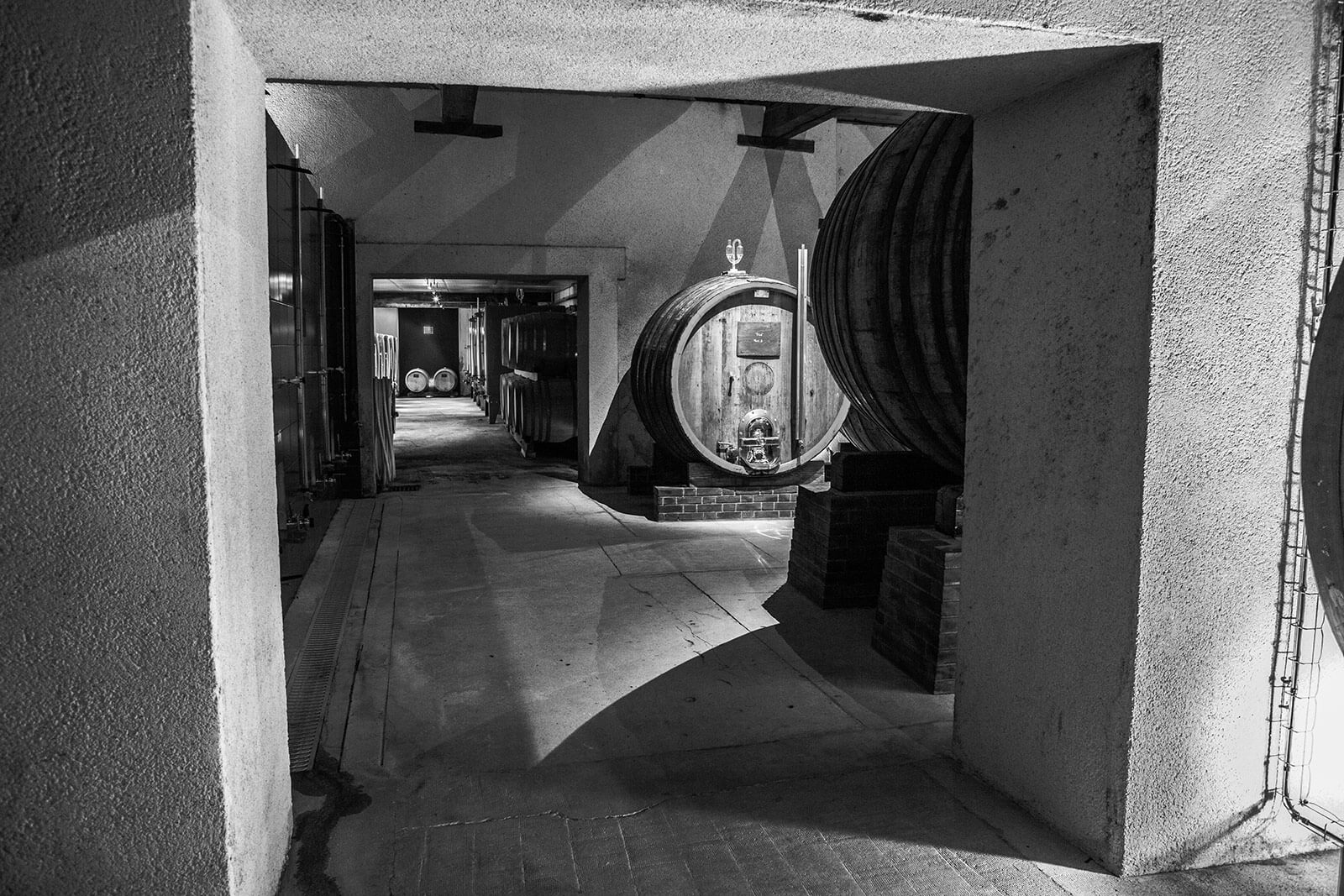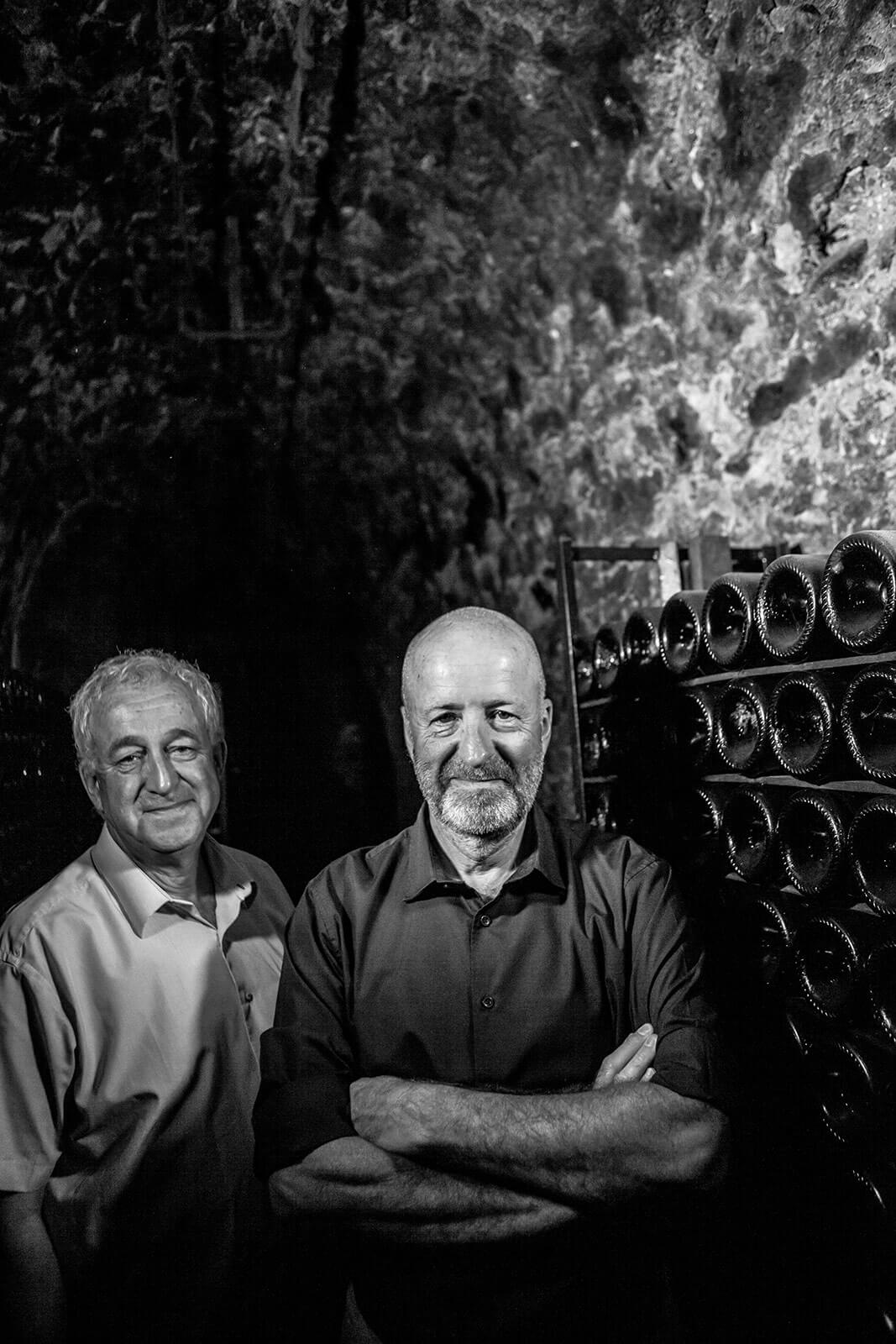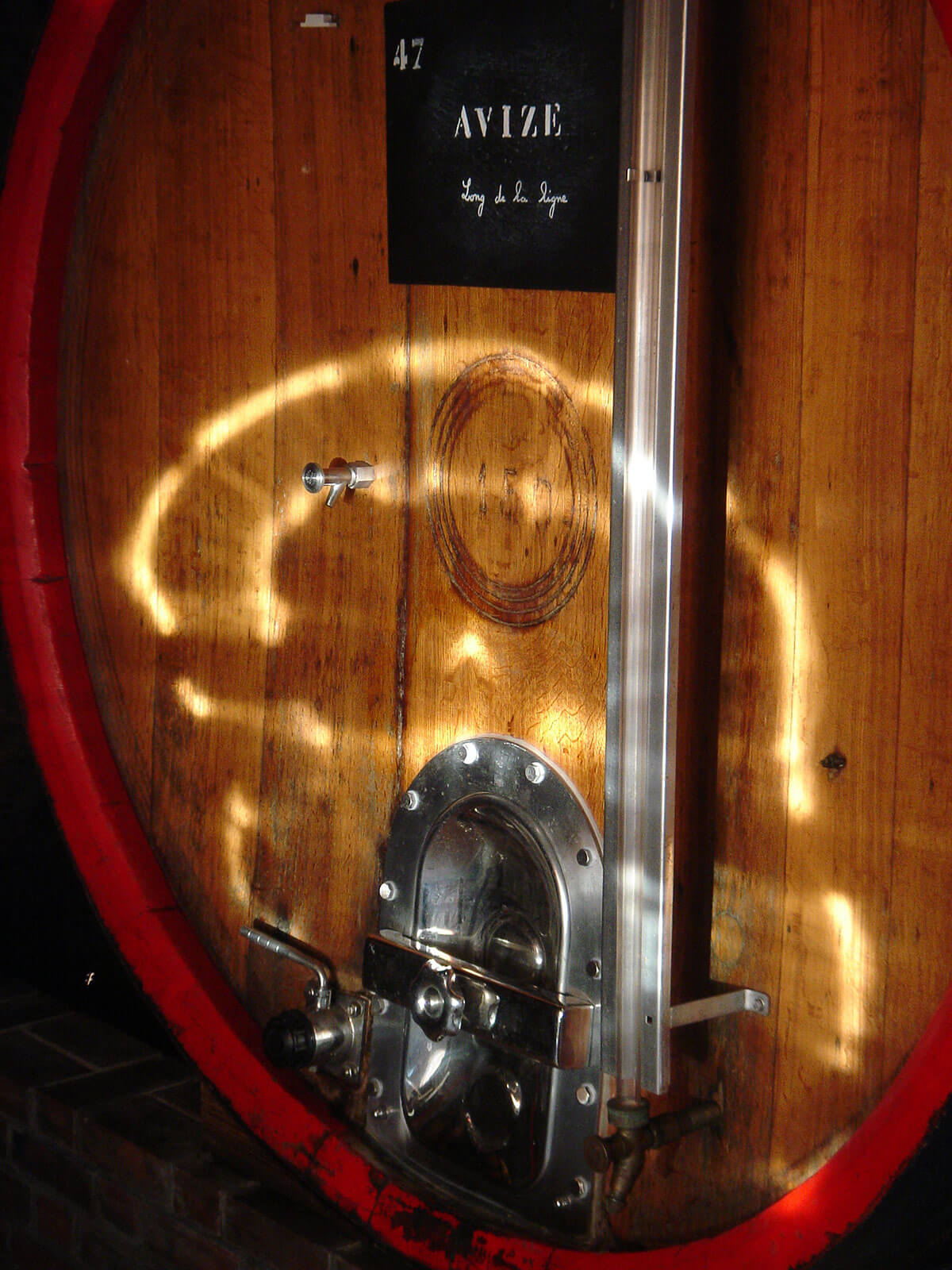Champagne Jacquesson: Superlative Grower Movement Single-Vineyard Wines
by Ken Gargett
Jacquesson is a wonderful champagne producer making wines of the highest caliber.
Champagne Jacquesson is an old house that has completely transformed itself, very much for the better. Perhaps more than any other, it forms a bridge between the new grower movement and the traditions of the classic producers. A visit there a few years ago ranks among the most interesting and enjoyable I have had in the Champagne region.

Jacquesson’s cellar
The history of Jaquesson
This venerable old house, originally based in Châlons-sur-Marne, was founded in 1798, making it arguably the oldest independent champagne house. The current owner, the Chiquet family, purchased the estate in 1974. Up until then, and indeed for a few more years under Jean Chiquet, it would be fair to say that it was an acceptable, if underwhelming, producer, probably most famous for the fact that in 1843 Johann-Joseph Krug left it to form his own house.
However, Jacquesson played an important role in the evolution of champagne. Adolphe Jacquesson worked with Dr. Jules Guyot in establishing a system of planting vines in rows. He also patented the muselet, the wire cage that holds the cork in place (no idea if Jaquesson is still receiving royalties from that, but if so it should be an extremely wealthy house).

Laurent and Jean-Hervé Jacquesson
Jean Chiquet’s son, Jean-Hervé, who joined in 1978, now looks after both the management of the estate and the winemaking. Winemaking brother Laurent joined eight years later.
Together they took over from their father in 1988, but they only “got the green light” after ten years of “negotiations” with him. One suspects that might be a euphemism for some rather forceful family debates. The brothers were keen to take the company from what they saw as “a champagne business” to a respected champagne house. The changes have been extensive.
Under their father, the estate had 15 hectares with another 30 under contract, producing a total of 450,000 bottles. Now the estate has expanded to 28 hectares, but the brothers reduced the area under contract to just 8 hectares, which is strictly controlled and farmed by them. Production is now only 270,000 bottles. The move to quality over quantity has been crucial to the success, even if it was anything but of the overnight variety.
As Jean-Hervé says, when they took over they had the location and opportunity “to be world champions.” They were determined to do everything they could “to suppress compromise.”
They found the early results disappointing. They were making better wines, but they lost their customer base. Their champagnes were simply too different. The brothers, however, were determined not to give up.
Between 2000 and 2002, they revamped the range. Jean-Hervé describes the frustration this caused in the short term, “We were forced to talk about the wines we were selling, not making.” It takes some time for champagne to work through the system, from vineyard to consumer, so what you make today may not reach your customers for five or even ten years – they are always selling their past in a way.
They faced a disadvantage that did not afflict many of the new wave of growers who have emerged. “It is more difficult to go from bad wines to good than it is from zero to good.”
It is worth noting that it took until 2019 before the brothers had worked through all previous stocks of both reserve wines and bottled champagnes. Since then, everything is from the new era.

Champagne Jacquesson: wine in barrel
The transformation at Jacquesson
Part of the transformation was the work in pioneering single-vineyard and terroir-based wines. Use of herbicides ceased. Out went the traditional non-vintage, vintage, and prestige champagnes and in came one blend – “the best we can make each year” – and four single-vineyard wines.
They had always made a champagne from Avize fruit, a non-vintage Blanc des Blancs. In 1990, they changed it to a vintage wine to take advantage of the best years – for them 1990, 1993, 1995, 1997, 2000, and 2002 (post 2002 is the new direction, discussed below).
Why no 1996, I asked, as ’96 was a very famous vintage in Champagne? For Jean-Hervé, 1996 was a great Pinot Noir year, but it did not give him what he wanted for this Blanc des Blancs. It meant that in “lesser” years, this fruit would go to improve “the one blend.”
For Jean-Hervé, it was all about “rediscovering our own terroir.” Jean-Hervé says that “inheriting a Champagne house made us frustrated growers.” This exploration of their terroir is one way of easing that frustration.

Pressing chardonnay grapes for Corne Bautray champagne at Jacquesson
Jean-Hervé noted three simple rules under which they operate. First, you need the terroir (the old story of silk purses/sows’ ears). Next, be prepared to work hard. Finally, be prepared to sell anything that you don’t believe is of the standard you have established. Their progress in the vineyard can be seen by the fact that in 2001 – granted, a horror year – they sold off 40 percent of the harvest. By 2010, another difficult year, this had dropped to just 12 percent.
Jaquesson’s vineyards are in the Grand Cru villages of Aÿ, Avize, and Oiry and the Premier Cru villages of Dizy, Mareuil-sur-Aÿ, and Hautvilliers.
The spark that lit the fire occurred in the spring of 1998. They were working on the 1997 contribution to the next Perfection NV and they loved what they had. But they realized it was “too Chardonnay” and that they would never be able to replicate it in future years – and of course, consistency is imperative when we talk non-vintage (we have seen that the house of Krug has also recognized that not every vintage is the same and it is also identifying each year in its multi-vintage – more appropriate nomenclature).
So, relegating that fruit, they ended up with a wine that “was less good” and that was simply unacceptable to the brothers.
The Rosé was ditched after the 1997 because they believed it was not a good wine, but at the same time there was faith that they could offer a quality example, especially as they had what they believed to be a good site in Dizy with Terres Rouge. Part of the problem was the quality, or lack thereof, of the red wine used for blending, so they moved to the saignée method.
The “blended wine” is the 700 Series, with the first being 728 (based on the 2000 vintage), then 729 and so on. “728” was simply the “technical number in the book” at that time – number 1 dates back to a cuvee from 1898, though these wines were not numbered on the labels. Basically, it meant this new champagne, Cuvee 728, was the 728th champagne that the house had made.
These changes meant it was imperative to provide information to customers about the new direction – such as disgorgement dates, dosage, cepage, number of bottles produced, the process, and more.
This new wine replacing the Perfection NV allowed the brothers to exhibit the very best from the vintage, free from the straitjacket of mediocrity imposed by the need to compromise for consistency.
As Jean-Hervé says, “If you want consistency, sometimes you need to make a lesser wine.” He does not see these wines as non-vintage, as they do not have that consistency from one year to the next – the first rule for the style. It was after the release of 735 that the decision was made to jettison those growers not up their exacting standards. They cut back from 14 growers to eight. Production also dropped by 20 percent. The latest for me is 742, reviewed below.
Then it was time to rethink the Jacquesson Vintage. The decision was made that 2002 would be the final “traditional” vintage release. From then on, the house would release four discrete vintage wines, each a single-vineyard wine. They would only be made in very good years, limited in quantity to what each vineyard provided.
The brothers wanted these single-vineyard wines to offer their own personality and especially to reflect their individual terroir. In addition, the fruit must not be required for the 700 Series. Stocks are retained so they can offer “Dégorgement Tardif” champagnes (those disgorged after an extended time on lees) down the track (similar to the Bollinger RD program). This gives the wines an immediate level of extra complexity.
Hence, we have the Champ Caïn, a Blanc des Blancs from Avize. Champ Caïn was one of the lieu-dits previously used in the vintage Avize. The Jacquesson parcel, planted in 1962, is 1.3 hectares.
Next, there is the Corne Bautray from Dizy. Planted in 1960, it has one hectare of Chardonnay.
From Aÿ, there is Vauzelle Terme, a mere 0.75 hectares of Pinot Noir, planted in 1980.
Finally, also from Dizy, Terres Rouges, from a 3.3-acre site that makes Rosé Saignée.
The four single-vineyard wines account for only about 10 percent of the production. The wines are held back for release – the 2002s hitting the market in 2011 and the 2004s in 2013. Only the Terres Rouges as a rosé is released younger. The 2008s are the current releases, with 2011 for the rosé.
Inevitably, not all of the sites perform to their required standards every year. Jean-Hervé says that 2008 and 2009 were so good they could make whatever they liked. 2010, however, was difficult and no single-vineyard wines were made. 2011 was problematic. Aÿ suffered from botrytis; Avize was good but not good enough; they could only make tiny quantities of Terres Rouges, but the star was Corne Bautray from Dizy.
They waited for as long as they could “and it was perfect.” However, it was needed for 739 so off it went, though a barrel was kept for the library. 2012 was very good and 2013 even better, especially for Pinot Noir. Less so in Dizy.
Jean-Hervé recognizes the DNA running through the vineyards. He sees it every year, but he says he is not looking for this to be apparent in the wines. He just wants the best wines possible, but he concedes that this form of consistency will be there.
As he says, “The source is consistent as is the taste of the two guys that blend. It does not change.”
The results? Jean-Hervé says that they have at least made their two best customers happy – Laurent and himself. They have made a lot of other champagne lovers very happy as well.
I have not seen much of the discrete sites since that visit, but the Avize Champ Caïn and Dizy Corne Bautray, both from 2004, impressed. 736, based on the 2008 vintage, was superb, shading the 737 based on the 2009 vintage. On the day, the 733 Degorgement Tardif was my pick.
The Degorgement Tardif program began with the 733. The brothers retain 15,000 to 20,000 bottles from each of the numbered series for extra aging, four to five years, on lees. The base of the 733 was the 2005 vintage, a year Jean-Hervé likes more than many, with 22 percent reserve wine. It was disgorged in September 2013.
The brothers will decide the order of the release of these wines at the appropriate time, meaning that some may spend even longer on lees. A similar program is in place for the later disgorgement of the single-vineyard wines, but it will not happen for some time.

Jacquesson Cuvée No. 742 Extra Brut NV
Tasting notes Jacquesson Cuvée No. 742 Extra Brut NV
Champagne Jacquesson Cuvée No.742 Extra Brut NV (AUD$125) is a blend of 59 percent Pinot Noir from Aÿ, Dizy, and Hautvillers with 41 percent Chardonnay from Avize and Oiry. The dosage is a mere 1.5 grams/liter. For the record, 222,044 bottles, 9,902 magnums, and 300 jeroboams were produced. Disgorged January 2019. The base wine is from 2014 – a wet winter, mild spring, cool and wet July and August, and then a hot, dry, and sunny September. Chardonnay was the star of the vintage.
Opens with a beguiling nose. Real complexity already evident. Hazelnuts, pears, florals, peaches. A hint of brioche. A well-structured champagne, finely balanced and with serious length. It really does linger. Underlying power but a champagne that really does dance. Perhaps a little more richness than some of the 700 Series. A cracking champagne. 95.
For more information, please visit www.champagnejacquesson.com/en/le-programme-2020.
You may also enjoy:
Bollinger RD 2004: When It Came To Champagne (And Much Else), Madame Bollinger Had Excellent Taste
Bollinger 2008 La Grande Année Champagne: Still Young, But Already A Classic
Leave a Reply
Want to join the discussion?Feel free to contribute!



Wow,
What a great read, well done to you both.
So so much hard work and dedication.
Where eventually it all paid off.
Once again well done.
Best regards
Ian Lord
Hi Ian. Thanks so much for your comments. Very much appreciated.